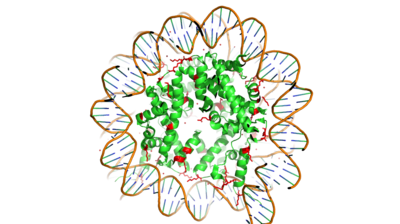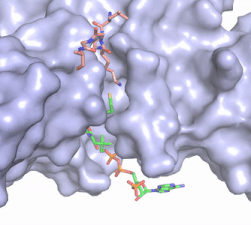User:Caitlin Marie Gaich/Sandbox1
From Proteopedia
(Difference between revisions)
| Line 14: | Line 14: | ||
= Hat1/Hat2 Complex Structure = | = Hat1/Hat2 Complex Structure = | ||
| - | Hat1 is not catalytically active until it binds with HAT2 to form the <scene name='81/811717/Complex/7'>complex</scene>. HAT1 structure, identified as <scene name='81/811717/Hat1_-_chain_a/2'>chain A</scene>, includes 317 residues and contains the binding site for acetyl-coenzyme A. HAT2 is identified as <scene name='81/811717/Hat2_-_chain_b/2'>chain B</scene>, which includes 401 residues. Bound to this complex is the histone protein <scene name='81/811717/Histone_4/3'>H4</scene> residues 1-38. | + | Hat1 is not catalytically active until it binds with HAT2 to form the <scene name='81/811717/Complex/7'>complex</scene>. HAT1 structure, identified as <scene name='81/811717/Hat1_-_chain_a/2'>chain A</scene>, includes 317 residues and contains the binding site for acetyl-coenzyme A. HAT2 is identified as <scene name='81/811717/Hat2_-_chain_b/2'>chain B</scene>, which includes 401 residues in a beta-propeller formation with C7 symmetry. Bound to this complex is the histone protein <scene name='81/811717/Histone_4/3'>H4</scene> residues 1-38. |
The HAT1 and HAT2 interface is stabilized by several interactions of multiple types. Most of these interactions are located in a HAT1 <scene name='81/811717/Lp1/5'>short, well-ordered helix</scene> of residues 200-208. This helix is thought to be important for the heterodimer formation as the deletion of the helix abolishes the interaction between HAT1 and HAT2. This suggests that there may be another protein involved, such as the N terminus tail of H4, acting as a linker protein interacting with the complex interface to further stabilize the complex interface. This HAT1/HAT2 interface is stabilized by <scene name='81/811717/Salt_bridges/4'>salt bridges</scene> between the two subunits. There are three major areas where hydrogen bonds are present aids in this complex formation. The side chain atoms of <scene name='81/811717/Tyr199_asp308_ala202/6'>Tyr199 and Asp308</scene> with the main chain nitrogen of Ala202 in HAT1. The side chain of <scene name='81/811717/Lys211phe205_and_leu288arg282/8'>Lys211 and Arg282</scene> makes hydrogen bonds with Leu288 and Phe205 respectively. The last area of hydrogen bonds between HAT1 and HAT is found between <scene name='81/811717/Serine_hydrogen_bonds/4'>Ser263 and Asp 206</scene>. The <scene name='81/811717/Hydrophobic_core/4'>hydrophobic core</scene> at the interface of the complex appears to be critical for the complex formation. This core consists of aromatic amino acids from HAT1 and leucine amino acids from HAT2, however it does not form any obvious ring stacking. | The HAT1 and HAT2 interface is stabilized by several interactions of multiple types. Most of these interactions are located in a HAT1 <scene name='81/811717/Lp1/5'>short, well-ordered helix</scene> of residues 200-208. This helix is thought to be important for the heterodimer formation as the deletion of the helix abolishes the interaction between HAT1 and HAT2. This suggests that there may be another protein involved, such as the N terminus tail of H4, acting as a linker protein interacting with the complex interface to further stabilize the complex interface. This HAT1/HAT2 interface is stabilized by <scene name='81/811717/Salt_bridges/4'>salt bridges</scene> between the two subunits. There are three major areas where hydrogen bonds are present aids in this complex formation. The side chain atoms of <scene name='81/811717/Tyr199_asp308_ala202/6'>Tyr199 and Asp308</scene> with the main chain nitrogen of Ala202 in HAT1. The side chain of <scene name='81/811717/Lys211phe205_and_leu288arg282/8'>Lys211 and Arg282</scene> makes hydrogen bonds with Leu288 and Phe205 respectively. The last area of hydrogen bonds between HAT1 and HAT is found between <scene name='81/811717/Serine_hydrogen_bonds/4'>Ser263 and Asp 206</scene>. The <scene name='81/811717/Hydrophobic_core/4'>hydrophobic core</scene> at the interface of the complex appears to be critical for the complex formation. This core consists of aromatic amino acids from HAT1 and leucine amino acids from HAT2, however it does not form any obvious ring stacking. | ||
| Line 28: | Line 28: | ||
= Mechanism = | = Mechanism = | ||
| - | + | After many structural studies, the catalytic mechanism for HAT1 remains unclear. A structural overlay of HAT1 and Gcn5, a better-understood HAT enzyme, found a conserved glutamate residue in the active site of both molecules. Previous studies found that a mutation at the active site glutamate residue greatly alters the catalytic ability of HAT1, proving it to be structurally important. <ref> DOI:10.1101/gad.240531.114 </ref> The crystallized structure of the HAT1/HAT2 complex supports, with the proximity of potentially catalytic residues, a mechanism for histone acetylation involving the following residues and cofactor: <scene name='81/811713/Mechanism_glu_lys_coa/1'>Glu255, H4Lys14, and Acetyl-CoA</scene>. | |
[[Image:HAT1_Mechanism.jpg|400px|right|thumb|Figure 3: Proposed HAT1 Mechanism]] | [[Image:HAT1_Mechanism.jpg|400px|right|thumb|Figure 3: Proposed HAT1 Mechanism]] | ||
| - | In this mechanism, the glutamate at residue 255 in the active site of the protein acts as a general base by deprotonating lysine 12 of histone 4 (the numbering of the modified lysine residue on histone 4 is shifted two residues in the | + | In this mechanism, the glutamate at residue 255 in the active site of the protein acts as a general base by deprotonating lysine 12 of histone 4 (the numbering of the modified lysine residue on histone 4 is shifted two residues in the featured structure).The deprotonated lysine then acts as a nucleophile and attacks the carbonyl carbon of Acetyl CoA (not shown in the structure), forming a tetrahedral transition state containing an oxyanion. The negative charge on the oxyanion is then shift to down to reform the double bond between the oxygen and carbonyl carbon, breaking the scissle bond between the carbonyl carbon and the sulfur atom of acetyl CoA. The resulting product of this reaction is histone 4 with an acetyl-lysine at residue 12 and coenzyme A. |
= Inhibition = | = Inhibition = | ||
| - | Although HAT1 was the first histone acetyltransferase enzyme discovered, it is | + | Although HAT1 was the first histone acetyltransferase enzyme discovered, it is difficult to study and is one of the least understood HAT enzymes. While HAT1 has been linked to many disease states, there is no current known inhibitor of HAT1 that exists. Developing an enzyme inhibitor for HAT1 could allow for therapeutic targets in diseases in which HAT1 has been implicated as well as be used as a tool to better understand the specificity and mechanism in which HAT1 acts to modify histones, in particular histone 4 (H4). HAT1 inhibitors containing the first 20 residues of H4, including the target lysine for modification, and acetyl-CoA and found H4K12CoA to act as a competitive inhibitor to both the peptide substrate as well as acetyl-CoA, potentially laying the foundation for new discovery and better understanding of HAT1 <ref> DOI: 10.1111/cbdd.13476 </ref> |
= References = | = References = | ||
<references/> | <references/> | ||
Revision as of 00:07, 26 April 2019
Histone Acetyltransferase HAT1/HAT2 Complex, Saccharomyces cerevisiae
| |||||||||||



